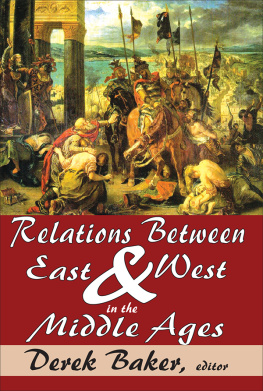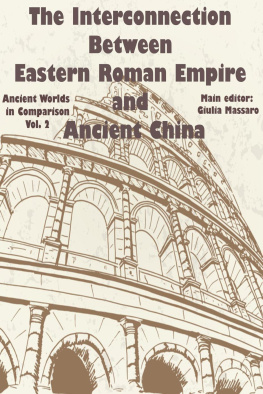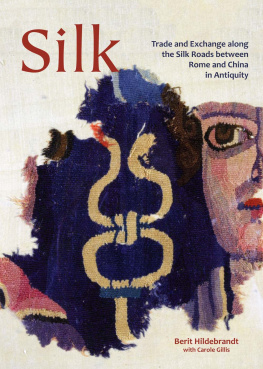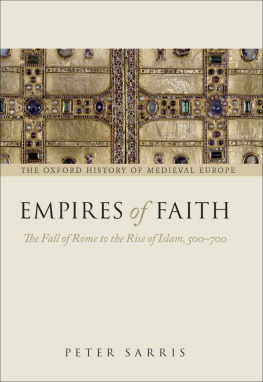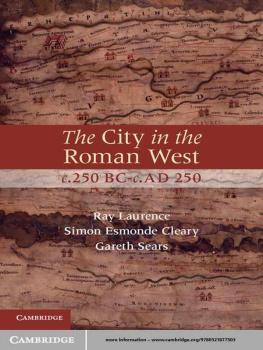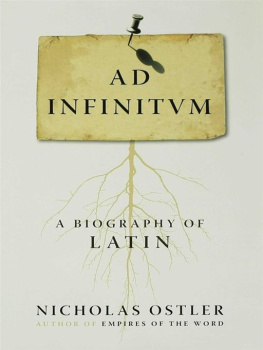First published 1973 by Transaction Publishers
Published 2017 by Routledge
2 Park Square, Milton Park, Abingdon, Oxon OX14 4RN
711 Third Avenue, New York, NY 10017, USA
Routledge is an imprint of the Taylor & Francis Group, an informa business
Copyright 1973 by Taylor & Francis.
All rights reserved. No part of this book may be reprinted or reproduced or utilised in any form or by any electronic, mechanical, or other means, now known or hereafter invented, including photocopying and recording, or in any information storage or retrieval system, without permission in writing from the publishers.
Notice:
Product or corporate names may be trademarks or registered trademarks, and are used only for identification and explanation without intent to infringe.
Library of Congress Catalog Number: 2009044713
Library of Congress Cataloging-in-Publication Data
Relations between East and West in the Middle Ages / [edited by]
Derek Baker.
p. cm.
Consists primarily of papers presented at a colloquium in medieval history organized by the Dept. of History, University of Edinburgh, in association with the Institute for Advanced Studies in the Humanities, Edinburgh, 1969. Originally published: Edinburgh : Edinburgh University Press, c1973.
Includes bibliographical references and index.
ISBN 978-0-202-36332-5 (acid-free paper)
1. Byzantine Empire--Relations--Europe--Congresses. 2. Europe--Relations--Byzantine Empire--Congresses. I. Baker, Derek, 1931-II. University of Edinburgh. Dept. of History. III. University of Edinburgh. Institute for Advanced Studies in the Humanities.
DF552.R4 2010
303.482495040902--dc22
2009044713
ISBN: 9781351493925 (ebk)
With one exception the papers presented here were delivered in March 1969 at the second colloquium in medieval history to be held at the university of Edinburgh. The colloquium was organised by the department of History in association with the Institute for Advanced Studies in the Humanities.
Dr Riley-Smiths paper arose out of the discussions which accompanied the colloquium papers, and the volume has been completed by the addition of Professor Nicols introductory study.
Derek Baker
University of Edinburgh
Contents
Donald M. Nicol
W.H.C.Frend
Karl Leyser
R.H.C.Davis
Anthony Bryer
Joseph Gill S.J.
Jonathan Riley-Smith
R.W.Southern
Anthony Bryer
Reader in Byzantine History,
University of Birmingham
R.H.C.Davis
Professor of Medieval History,
University of Birmingham
W.H.C.Frend
Professor of Ecclesiastical History,
University of Glasgow
Joseph Gill S.J.
Lecturer in Church History,
Campion Hall, Oxford
Karl Leyser
Magdalen College, Oxford
Donald M. Nicol
Koras Professor of Modern Greek and Byzantine History, Language and Literature,
Kings College, London
Jonathan Riley-Smith
Queens College, Cambridge
R.W.Southern
President, St Johns College, Oxford
ACO | Acta Conciliorum Oecumenicorum, 4 vols in 12, ed. E. Schwartz (Berlin/Leipzig 191440) |
Byz | Byzantion (Brussels/Boston 1924) |
BZ | Byzantinische Zeitschrift (Leipzig 1892) |
CSCO | Corpus Scriptorum Christianorum Orientalium, ed. J. B. Chabot and others (Paris/Rome etc 1903) |
CSEL | Corpus Scriptorurm Ecclesiasticorum Latinorum (Vienna 1886) |
CSHB | Corpus Scriptorum Historiae Byzantinae (Bonn 182897) |
DOP | Dumbarton Oaks Papers (Cambridge, Mass., 1941) |
HE | Historia Ecclesiastica |
Hefele-Leclercq | K. J. Hefele and H. Leclercq, Histoire des Conciles, 8 vols in 16 (Paris 190721) |
Mansi | J.D.Mansi, Sacrorum conciliorum nova et amplissima collectio, 31 vols (Florence/Venice 175798); new impression and continuation ed. L.Petit and J.B.Martin, 60 vols (Paris 190127) |
MGH | Monumenta Germaniae Historica inde ab a. c. 500 usque ad a, 1500, ed. G.H.Pertz etc. (Berlin/Hanover 1826) |
SRG | Scriptorum rerum germanicarum |
SS | Scriptores |
PG | Patrologia Graeca, ed. J.P.Migne, 161 vols in 166 (Paris 185766) |
PL | Patrologia Latina, ed. J.P.Migne, 217+4 vols (Paris 1841-64) |
PO | Patrologia Orientalis, ed. J.Graffin and F.Nau (Paris 1903) |
RHC | Recueil des Historiens des Croisades (Paris 1841) |
RHE | Revue dHistoire Ecclsiastique (Louvain 1900) |
RS | Rerum Britannicarum Medii Aevi Scriptores, 99 vols (London 18581911) Rolls Series |
Introduction
Donald M. Nicol
The essays here gathered together were the intellectual wines poured out at a symposium held at Edinburgh in 1969. Its theme was EastWest contacts in the Middle Ages. The title was taken to apply to relations between eastern and western Europe, or between the eastern and western parts of the old GraecoRoman world, and not to contacts between, for instance, France and Far Cathay.
To the founder of the Roman Empire and his successors relations between East and West meant relations between the eastern and western parts of a whole, the pars orientalis and the pars occidentalis of the unified structure of the empire. Roman poets liked to boggle the minds of their listeners by talking of a dominion that extended from the barbarous Britons at one end to the perfidious Parthians at the other. But the dominion was one. Jupiter, if Vergil is to be believed, granted to Romulus and his Romans an imperium without limits and without end. Augustus nevertheless wisely decided that his empire should have manageable territorial boundaries. But within the limits that he set Roman, Greek, Jew, Christian and Gentile could live under the same law. Romans of the old school sometimes complained about the corrupting influence on their city of Greeks and orientals, of the Orontes flowing into the Tiber. But they employed Greek tutors to educate their sons. People did not think of the eastern and western parts of the empire as being separate entities whose relations with each other must be the object of careful study.
Even at the moment of the empires birth, however, there was already a clear idea of where the Latin West ended and the Greek East began. The Roman historian Appian tells us that when, in 44 bc, Octavian and Mark Antony divided the world between them, they drew a line down their map from north to south. The line passed through the Dalmatian town of Scodra on the Adriatic Sea. Everything to the east of that line, as far as the Euphrates,was to belong to Antony; everything to the west of it, as far as the Atlantic Ocean, was to belong to Octavian. It was a remarkably realistic division. When the structure of the Roman Empire cracked in later centuries, the crack appeared more or less down that seam; and in the Middle Ages it was across that line that Byzantines and westerners maintained their tenuous contacts. Most of what lay to the west of Scodra was lost to the Roman world in the fifth century. Yet the emperors reigning in Constantinople regarded the loss as being only temporary. Barbarians had unhappily usurped authority in the West. But the empire had not fallen apart; and in Gods good time the barbarians would either come to learn or to be forcibly taught their rightful place in the imperial scheme of things. Justinian, as a true successor of Augustus, Trajan and Constantine, made it his lawful business to restore order to the world byreestablishing Roman rule over the western provinces. Given the means and the opportunities to do so he had no option. He would have been failing in his imperial duty if he had not seized those opportunities; and, as Professor Frend points out in the first of the essays in this volume, most of Justinians subjects probably shared the common pride in the enterprise of reconquest. But the cost of that enterprise, in terms of human suffering as well as of hard cash, was more than the empire could sustain; and even by Justinians time reintegration of the empire had already been rendered almost impossible by reason of the differences among its members in matters of theology and ecclesiology. Christianity proved to be an even more potent factor than language, culture, or barbarian conquest in the division of the structure.

